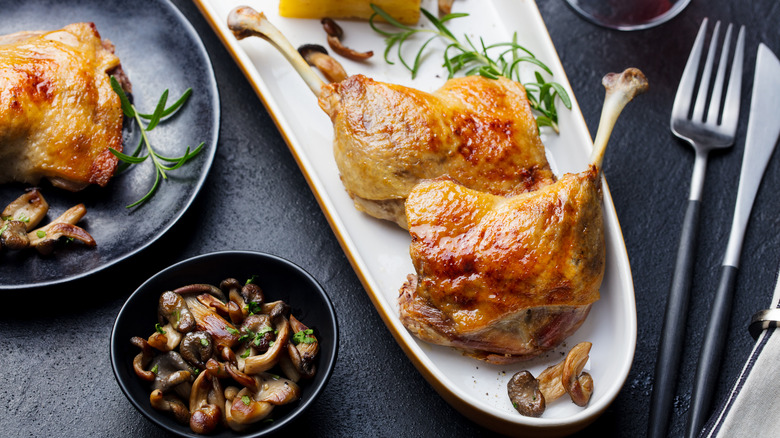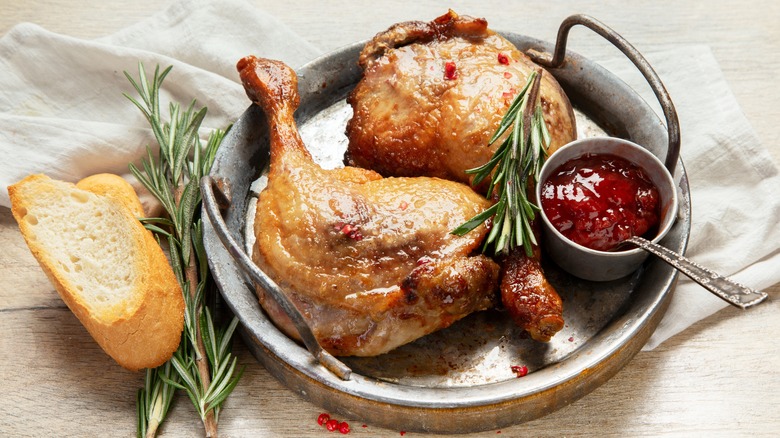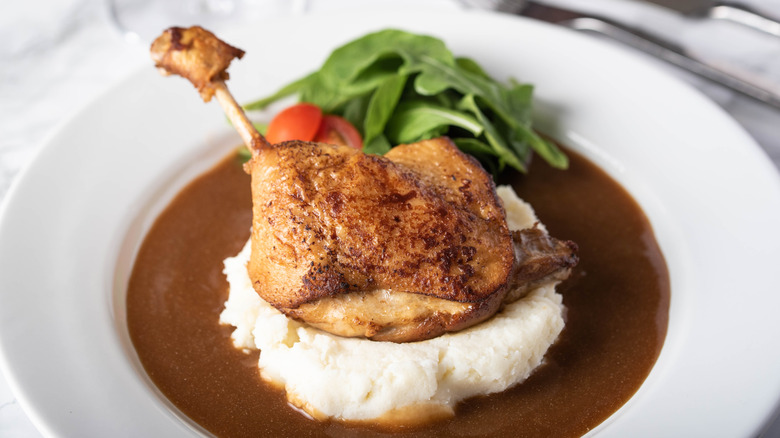The Perfect Canned Protein For A Quick Gourmet Meal You're Overlooking
We may receive a commission on purchases made from links.
Duck is one of those proteins that's generally more often ordered out, rather than made at home. Though it's not too hard to break down a whole duck, cooking one tends to be a little more involved than your average chicken. The higher fat content allows for slow cooking and requires rendering, but to avoid a gamey taste, you also need to soak the bird for several hours. Then if you want to make duck leg confit — one of the more popular traditional methods of preparing duck — you're looking at another eight hours of cooking time. Fortunately, there's a little-known hack: Canned duck confit is an easy way to incorporate this flavorful, extra-fancy meat into a wide variety of dishes.
While canned or jarred duck confit is popular throughout southwestern France, it's possible that your cat or dog has eaten more of it than you have. There just aren't that many brands on store shelves outside of France, so it's time to stock up. After all, canned duck is rich and flavorful, and arguably one of those canned delicacies that is just as good as its fresh version.
Incorporating canned duck confit into meals
Once you open a can of duck confit, using the meat is pretty straightforward. Packed in its own fat, it's pre-cooked and ready to serve with a bit of prep. Heat the meat in the oven (there may be four to six legs to a can), then place it over a frisée salad or alongside mashed potatoes. You can also shred or dice the meat, incorporating it into stews, salads, and more.
Once the shredded meat is ready, it makes for an easy gourmet upgrade to all kinds of dishes. Spread shredded confit out on a baking sheet and crisp it in the oven before adding it to salads, beans, or as a pizza topping. Change up your birria or machaca recipe by swapping out beef for duck and use it in tacos and enchiladas. Duck in a bánh mi-style sandwich adds an intense flavor note that is sometimes missing with chicken or pork. Or slow cook diced duck in a stew with shredded cabbage, broth, and white wine to make a simplified Garbure stew. Anything you can do with diced or shredded beef, pork, or chicken you can do with canned duck.
Be sure and save the fat in which the duck confit was packed. Duck fat is an indulgent and easy way to improve many foods, making for decadent fried potatoes, roasted vegetables, or old-fashioned pan-popped popcorn. If the fat that comes with the duck isn't enough, you can buy a whole can of Straight From France all-natural duck fat and go wild.
Duck confit was created for long-term storage
Confit is a French term that translates to preserved, which is a clue to how the cooking technique came about. Prior to refrigeration, preparing food in a way that it could last a long time was vital. The advantage of duck is that slow cooking it in a pan with its own fat creates a delectable, semi-dry meat that can last for months when stored in a cool place. The technique is most associated with the Gascony region of France, where it's commonly incorporated into gourmet dishes. Today, you'll still find it sold throughout southwestern France in regional stores whole, jarred, or canned.
The rest of us generally enjoy the whole leg in restaurant dishes with lentils or in a cassoulet. But canning or packing duck for later is actually kind of the entire point. So when you pick up canned duck, it's not intended to serve as an inferior stand-in, the way a canned stew might. Instead, you'll be indulging in a delicious product like Rougie confit of duck leg or Secret de chef duck confit. The canned version is convenient, luxurious, and worth keeping stocked in your cupboard for last-minute additions to recipes. You can also find whole duck leg confit vacuum packed in plastic, ready to be heated and added whole to dishes, or broken down for other recipes. Look for these at specialty grocery stores or online at sites like D'Artagnan. You can even order a three-pack of duck leg confit from Amazon.


